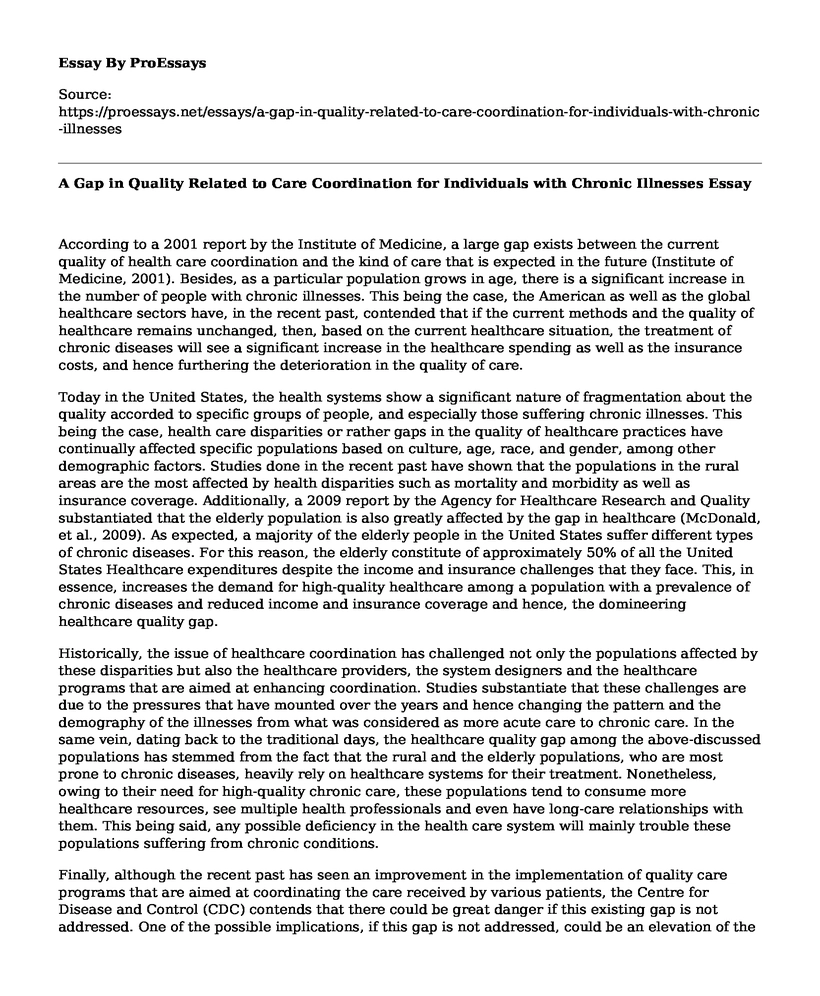According to a 2001 report by the Institute of Medicine, a large gap exists between the current quality of health care coordination and the kind of care that is expected in the future (Institute of Medicine, 2001). Besides, as a particular population grows in age, there is a significant increase in the number of people with chronic illnesses. This being the case, the American as well as the global healthcare sectors have, in the recent past, contended that if the current methods and the quality of healthcare remains unchanged, then, based on the current healthcare situation, the treatment of chronic diseases will see a significant increase in the healthcare spending as well as the insurance costs, and hence furthering the deterioration in the quality of care.
Today in the United States, the health systems show a significant nature of fragmentation about the quality accorded to specific groups of people, and especially those suffering chronic illnesses. This being the case, health care disparities or rather gaps in the quality of healthcare practices have continually affected specific populations based on culture, age, race, and gender, among other demographic factors. Studies done in the recent past have shown that the populations in the rural areas are the most affected by health disparities such as mortality and morbidity as well as insurance coverage. Additionally, a 2009 report by the Agency for Healthcare Research and Quality substantiated that the elderly population is also greatly affected by the gap in healthcare (McDonald, et al., 2009). As expected, a majority of the elderly people in the United States suffer different types of chronic diseases. For this reason, the elderly constitute of approximately 50% of all the United States Healthcare expenditures despite the income and insurance challenges that they face. This, in essence, increases the demand for high-quality healthcare among a population with a prevalence of chronic diseases and reduced income and insurance coverage and hence, the domineering healthcare quality gap.
Historically, the issue of healthcare coordination has challenged not only the populations affected by these disparities but also the healthcare providers, the system designers and the healthcare programs that are aimed at enhancing coordination. Studies substantiate that these challenges are due to the pressures that have mounted over the years and hence changing the pattern and the demography of the illnesses from what was considered as more acute care to chronic care. In the same vein, dating back to the traditional days, the healthcare quality gap among the above-discussed populations has stemmed from the fact that the rural and the elderly populations, who are most prone to chronic diseases, heavily rely on healthcare systems for their treatment. Nonetheless, owing to their need for high-quality chronic care, these populations tend to consume more healthcare resources, see multiple health professionals and even have long-care relationships with them. This being said, any possible deficiency in the health care system will mainly trouble these populations suffering from chronic conditions.
Finally, although the recent past has seen an improvement in the implementation of quality care programs that are aimed at coordinating the care received by various patients, the Centre for Disease and Control (CDC) contends that there could be great danger if this existing gap is not addressed. One of the possible implications, if this gap is not addressed, could be an elevation of the healthcare spending as well as the insurance levels for those with chronic diseases. This, in essence, would mean that the healthcare sectors will lack organizations to treat those with chronic conditions in a coordinated team approach (Garfield & Damico, 2016).
References
Garfield, R., & Damico, A. (2016, October 19). The Coverage Gap: Uninsured Poor Adults in States that Do Not Expand Medicaid | The Henry J. Kaiser Family Foundation. Retrieved from http://kff.org/uninsured/issue-brief/the-coverage-gap-uninsured-poor-adults-in-states-that-do-not-expand-medicaid/
McDonald, K. M., Sundaram, V., & Bravata, D. M. (2009). Closing the Quality Gap: A Critical Analysis of Quality Improvement Strategies Volume 1-Series Overview and Methodology. Technical Review, Number 9. PsycEXTRA Dataset, 9(7). doi:10.1037/e439892005-001
Institute of Medicine. (2001). Crossing the quality chasm: A new health system for the 21st century (Vol. 2001). Washington D.C.: National Academy Press.
Cite this page
A Gap in Quality Related to Care Coordination for Individuals with Chronic Illnesses. (2021, Jun 18). Retrieved from https://proessays.net/essays/a-gap-in-quality-related-to-care-coordination-for-individuals-with-chronic-illnesses
If you are the original author of this essay and no longer wish to have it published on the ProEssays website, please click below to request its removal:
- Health Problems Among Seniors Essay
- The Issue of Power in Nursing Leadership Essay
- Utilitarianism and Illegal Abortions Essay Example
- Proposal for Community-Based Care Transitions Program (CCTP)
- Scientific Rigor: A Value in Nursing for Evidence-Based Thinking - Essay Sample
- Seizures: Types & Causes - Essay Sample
- Essay Example on Providers: Delivering Care & Preventing Infectious Diseases for Disadvantaged Communities







